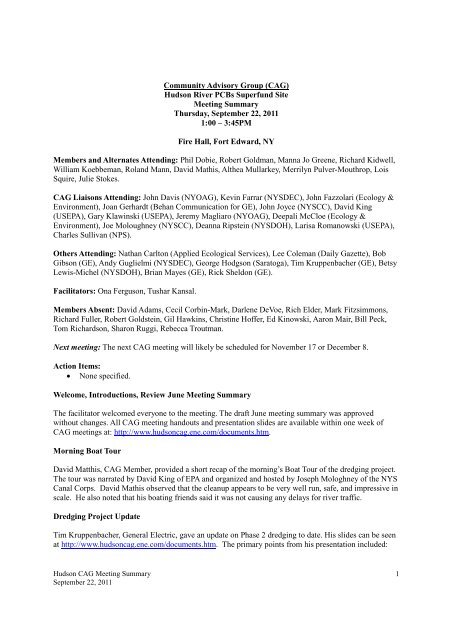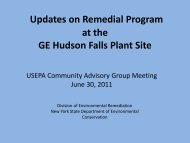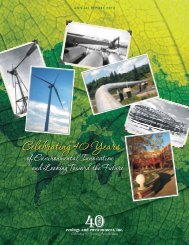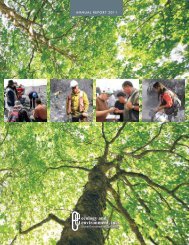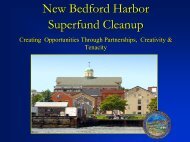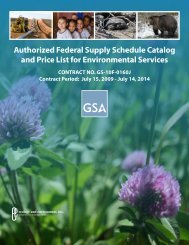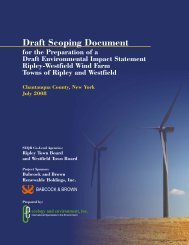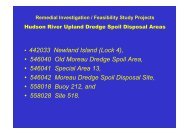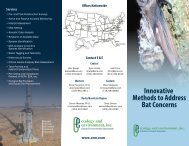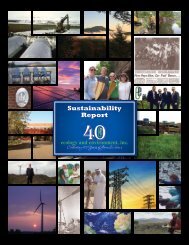Final Meeting Summary - Hudson River - Community Advisory Group
Final Meeting Summary - Hudson River - Community Advisory Group
Final Meeting Summary - Hudson River - Community Advisory Group
Create successful ePaper yourself
Turn your PDF publications into a flip-book with our unique Google optimized e-Paper software.
<strong>Community</strong> <strong>Advisory</strong> <strong>Group</strong> (CAG)<strong>Hudson</strong> <strong>River</strong> PCBs Superfund Site<strong>Meeting</strong> <strong>Summary</strong>Thursday, September 22, 20111:00 – 3:45PMFire Hall, Fort Edward, NYMembers and Alternates Attending: Phil Dobie, Robert Goldman, Manna Jo Greene, Richard Kidwell,William Koebbeman, Roland Mann, David Mathis, Althea Mullarkey, Merrilyn Pulver-Mouthrop, LoisSquire, Julie Stokes.CAG Liaisons Attending: John Davis (NYOAG), Kevin Farrar (NYSDEC), John Fazzolari (Ecology &Environment), Joan Gerhardt (Behan Communication for GE), John Joyce (NYSCC), David King(USEPA), Gary Klawinski (USEPA), Jeremy Magliaro (NYOAG), Deepali McCloe (Ecology &Environment), Joe Moloughney (NYSCC), Deanna Ripstein (NYSDOH), Larisa Romanowski (USEPA),Charles Sullivan (NPS).Others Attending: Nathan Carlton (Applied Ecological Services), Lee Coleman (Daily Gazette), BobGibson (GE), Andy Guglielmi (NYSDEC), George Hodgson (Saratoga), Tim Kruppenbacher (GE), BetsyLewis-Michel (NYSDOH), Brian Mayes (GE), Rick Sheldon (GE).Facilitators: Ona Ferguson, Tushar Kansal.Members Absent: David Adams, Cecil Corbin-Mark, Darlene DeVoe, Rich Elder, Mark Fitzsimmons,Richard Fuller, Robert Goldstein, Gil Hawkins, Christine Hoffer, Ed Kinowski, Aaron Mair, Bill Peck,Tom Richardson, Sharon Ruggi, Rebecca Troutman.Next meeting: The next CAG meeting will likely be scheduled for November 17 or December 8.Action Items: None specified.Welcome, Introductions, Review June <strong>Meeting</strong> <strong>Summary</strong>The facilitator welcomed everyone to the meeting. The draft June meeting summary was approvedwithout changes. All CAG meeting handouts and presentation slides are available within one week ofCAG meetings at: http://www.hudsoncag.ene.com/documents.htm.Morning Boat TourDavid Matthis, CAG Member, provided a short recap of the morning’s Boat Tour of the dredging project.The tour was narrated by David King of EPA and organized and hosted by Joseph Mologhney of the NYSCanal Corps. David Mathis observed that the cleanup appears to be very well run, safe, and impressive inscale. He also noted that his boating friends said it was not causing any delays for river traffic.Dredging Project UpdateTim Kruppenbacher, General Electric, gave an update on Phase 2 dredging to date. His slides can be seenat http://www.hudsoncag.ene.com/documents.htm. The primary points from his presentation included:<strong>Hudson</strong> CAG <strong>Meeting</strong> <strong>Summary</strong>September 22, 20111
Schedule, Scope and General Updates – Dredging started June 6 and is operating on a 24/6 schedule withprocessing on the 7 th day. May storms and bad weather delayed the start of the dredging season.Dredging has begun on Certification Unit (CU) 9, west of Roger’s Island and proceeded south. In riveroperations began initially with one dredge, then two, and a third dredge has since been added. Dredgedsediments are being processed seven days a week. This season, dredging has taken place in 11 CUs. CU21 is the furthest point south that dredging has proceeded to date. In addition, 216,000 cubic yards (cy) ofmaterial have been dredged as of September 18 out of a seasonal target of 350,000cy. 146,000 tons ofmaterial have been used for backfill and capping. To this point, the project has a nodal capping index of1.4%, representing dredged areas that have been capped. In total, about 5.7% of the area has been capped(including areas that do not count toward the nodal capping index). Dredging will likely continue untillate October. This year the dredging has achieved 65-70% efficiency compared to 40% efficiency in2009.Best Management Practices, Resuspension and Processing Facility Improvements – This season, ascompared to 2009, a number of improvements have increased efficiency while keeping resuspension low.These improvements include limiting the number of dredge passes; fewer dredges operatingsimultaneously; dredging in contiguous CUs; having a better understanding of the Depth ofContamination (DoC); and a simplified CU acceptance process. CUs are typically accepted within a 5-dayperiod. The term “acceptance process” describes a multi-step process by which EPA determines that a CUhas been dredged to a level of PCB concentration below acceptable limits. GE has also upgraded variouspieces of equipment at the processing facility, so things are moving faster and better in many systems.Better defined dredge prisms have led to increased accuracy and efficiency. There is a new sedimentunloader; an improved barge haul system; a new barge decant station; a new trommel feed system and anadditional bank of hydrocyclones. Also, material undergoes additional washing in the trommel; and thesize of the polymer feed system has been increased. This season, the processing facility has unloaded ~400 barges of material and 13 trains have shipped materials to disposal sites in Michigan and Idaho.Habitat Reconstruction – Replanting was necessary in most of the Phase 1 dredge areas and was doneduring June and July, 2011. The design of the 2011 dredge area reconstruction is underway.CAG members discussed the following topics in response to this presentation:• Debris – A CAG member asked about debris being dredged and was told that most debris ispulled up during the first dredge pass this season.• Dredge Materials on Site – A CAG member asked if it was likely that, like in 2009, dredgedmaterials would remain in piles on site during the winter. GE responded that it was too early totell. GE’s operations are on track, and there should be no backup at the landfills, but tropicalstorms in late summer caused railroad damage that might cause transport backups.• Navigational Dredging – CAG members asked about depth of caps this season (all are required toprovide a water depth of 14 feet or more), whether the Canal Corps would be able to dredge thenewly silted-over caps without harming the cap (e.g., in the Fort Edward Yacht Basin) andwhether dropping an anchor or dredging an area that has been capped will disturb the cap andpotentially allow for the release of PCBs. An EPA official stated that no caps have been placed inthe navigational channel this year. An EPA official noted that heavy spuds could penetrate thecap but that recreational anchors probably would not. CAG members later noted the need torestore the full use of the river for navigational dredging, and possible overlap between the CanalCorporation’s navigational dredging needs and the additional 136 acres delineated by the NRDTrustees.• Sediment Redistribution and Resilting– A CAG member noted that there has been resilting at theFort Edward Yacht Basin and asked if there have been any findings about contamination there.An EPA official responded that new sediment from up-river in closed CUs is not within the<strong>Hudson</strong> CAG <strong>Meeting</strong> <strong>Summary</strong>September 22, 20112
purview of this project and that NYSCC will conduct testing at the Yacht Basin. A CAG memberinquired as to how GE can test the soundness of the cap through 10 feet of silt. A GE officialresponded that GE can use bathymetric surveys to conduct tests and would look for differencesbetween surveys. Findings to date indicate that there has been no movement in the caps. This isthe case even in CU 1, where sediment deposition has occurred on top of the cap and has notdisturbed the integrity of the cap.• Record of Decision – A CAG member noted that there are significant concentrations of PCBsoutside the area defined by the record of decision, that these areas will not be addressed by thecleanup process, and that the next record of decision (on the floodplains) should be moreresponsive and adaptive to new developments and findings.Floodplain Sampling and Remedial ActionGary Klawinski, US EPA, presented about past and current sampling by EPA and GE of PCBs in the<strong>Hudson</strong> <strong>River</strong> floodplains. His slides can be seen at http://www.hudsoncag.ene.com/documents.htm.The EPA has an agreement with GE to evaluate PCB contamination in use areas and to conduct removalactions; both components of this work are near completion. GE and EPA evaluated flood mud thissummer and sampling is still underway, as it has been since 2000. Findings indicate that PCBs are morecommonly found in low-lying areas that are more often flooded and are more commonly found closer tothe river. Between 2008 and 2010, approximately 8,000 samples were collected across 400 properties.Of these, about 80% showed 10 ppm. 99% of samples in agriculturalfields were
heart disease and stroke. Her slides can be seen at http://www.hudsoncag.ene.com/documents.htm. Thestudy found that there was no significant effect of living close to the river and that income levels play amuch more significant role in correlation with hospitalization for heart disease and stroke. In response toa question from a CAG member, Dr. Lewis said she concludes that Dr. Carpenter’s study overstates theimplications on health of living close to the river.Brief UpdatesNYSCC Canalway Grant Program – John Joyce, NYS Canal Corps, a consolidated funding opportunitythat allows government bodies and nonprofits to submit a common application for grants from nine stateagencies. A total of $1 million is available and each grant is about $100,000-$150,000. Applications arebeing accepted now until October 31, 2011. Many types of projects would be eligible for support,including expanding public access, promoting tourism and econ development, protecting environmentaland historic canal resources, and many others. For more info see: www.nyworks.ny.gov.Navigational Access and Navigational Dredging – John Davis from the Attorney General's office reportedthat he had briefed his management on this issue, and that the AG leadership understands the salientissuesTAG Grant – Manna Jo Greene, <strong>Hudson</strong> <strong>River</strong> Sloop Clearwater, said that Dr. Peter deFur, TAG advisor,is analyzing data about air and water exceedances. She will be asking him to look at the potential effectsof not dredging the 136 acres of PCB-contaminated surface sediments that are outside of the Dredge AreaDelineation, which the Natural Resource Damage Trustees have raised concerns about with regard to fishtissue, and how soon humans could safely eat fish again with or without removing this additional acreage.She also noted concerns about whether possible NRD projects, such as restoring mink (whosereproductive capacity has been damaged by PCB exposure) to the shores of the <strong>Hudson</strong>, would beimpacted by this. And she raised concerns about habitat restoration, including the impact of dredging onfreshwater mussels and the need for greater diversity of aquatic plantings. Another CAG memberexpressed hope that there be opportunities to adaptively add issues such as mussel restoration into projectactivities as needs are identified.CAG BusinessCAG <strong>Meeting</strong> Date and Topics – The next CAG meeting may occur on November 17 th or December 8 th(after the dredge season is over) and will present as much data as possible from the 2011 dredge season.CAG members requested discussion at future meetings of mussel habitat, plant uptake of PCBs.Expanding CAG Membership – In June, a CAG member asked whether the CAG should expand toinclude other down-river communities. Participants discussed this question and determined that there arecommunities down-river with CAG representatives who do not attend because they do not haveimmediate concerns. When other communities indicate interest, they will likely be welcome to join.CAG Membership – Brian Gilchrest of the Washington County of Cornell Cooperative Extension willjoin the CAG as the Agricultural representative.AdjournThe meeting was adjourned at 4:00pm.<strong>Hudson</strong> CAG <strong>Meeting</strong> <strong>Summary</strong>September 22, 20114


